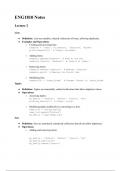Class notes
Lecture notes ENGG1810
- Course
- Institution
Enhance your understanding of Python programming with these detailed ENGG1810 USYD course notes. This document is designed to support students in grasping the fundamentals of Python and advancing through more complex topics effectively. Ideal for students and professionals, these notes cover essent...
[Show more]



